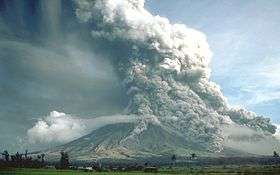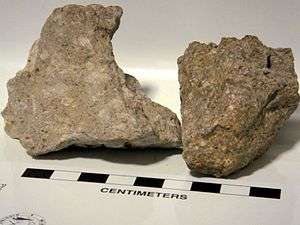Pyroclastic flow


A pyroclastic flow (also known scientifically as a pyroclastic density current[1]) is a fast-moving current of hot gas and rock (collectively known as tephra), which reaches speeds moving away from a volcano of up to 700 km/h (450 mph).[2] The gas can reach temperatures of about 1,000 °C (1,830 °F). Pyroclastic flows normally hug the ground and travel downhill, or spread laterally under gravity. Their speed depends upon the density of the current, the volcanic output rate, and the gradient of the slope. They are a common and devastating result of certain explosive volcanic eruptions.
Origin of term
The word pyroclast is derived from the Greek πῦρ, meaning "fire", and κλαστός, meaning "broken in pieces". A name for some pyroclastic flows is nuée ardente (French, "burning cloud"); this was first used to describe the disastrous 1902 eruption of Mount Pelée on Martinique.[3] In the dark, these pyroclastic flows glowed red.
Pyroclastic flows that contain a much higher proportion of gas to rock are known as "fully dilute pyroclastic density currents" or pyroclastic surges. The lower density sometimes allows them to flow over higher topographic features or water such as ridges, hills, and the sea. They may also contain steam, water and rock at less than 250 °C (482 °F); these are called "cold" compared with other flows, although the temperature is still lethally high. Cold pyroclastic surges can occur when the eruption is from a vent under a shallow lake or the sea. Fronts of some pyroclastic density currents are fully dilute; for example, during the eruption of Mount Pelée in 1902, a fully dilute current overwhelmed the city of Saint-Pierre and killed nearly 30,000 people.[4]
A pyroclastic flow is a type of gravity current; in scientific literature they are sometimes abbreviated to PDC (pyroclastic density current).
Causes
There are several mechanisms that can produce a pyroclastic flow:
- Fountain collapse of an eruption column from a Plinian eruption (e.g., Mount Vesuvius's destruction of Pompeii, see Pliny the Younger). In such an eruption, the material ejected from the vent heats the surrounding air and the turbulent mixture rises, through convection, for many kilometres. If the erupted jet is unable to heat the surrounding air sufficiently, convection currents will not be strong enough to carry the plume upwards and it falls, flowing down the flanks of the volcano.
- Fountain collapse of an eruption column associated with a vulcanian eruption (e.g., Montserrat's Soufrière Hills volcano has generated many of these deadly pyroclastic flows and surges.) The gas and projectiles create a cloud that is denser than the surrounding air and becomes a pyroclastic flow.
- Frothing at the mouth of the vent during degassing of the erupted lava. This can lead to the production of a rock called ignimbrite. This occurred during the eruption of Novarupta in 1912.
- Gravitational collapse of a lava dome or spine, with subsequent avalanches and flow down a steep slope (e.g., Montserrat's Soufrière Hills volcano, which caused nineteen deaths in 1997).
- The directional blast (or jet) when part of a volcano explodes or collapses (e.g., the May 18, 1980, eruption of Mount St. Helens). As distance from the volcano increases, this rapidly transforms into a gravity-driven current.
Size and effects

The volumes range from a few hundred cubic meters to more than a thousand cubic kilometres. The larger ones can travel for hundreds of kilometres, although none on that scale have occurred for several hundred thousand years. Most pyroclastic flows are around one to ten cubic kilometres and travel for several kilometres. Flows usually consist of two parts: the basal flow hugs the ground and contains larger, coarse boulders and rock fragments, while an extremely hot ash plume lofts above it because of the turbulence between the flow and the overlying air, admixing and heating cold atmospheric air causing expansion and convection.[5]
The kinetic energy of the moving boulders will flatten trees and buildings in their path. The hot gases and high speed make them particularly lethal, as they will incinerate living organisms instantaneously:
- The towns of Pompeii and Herculaneum, Italy, for example, were engulfed by pyroclastic surges in 79 AD with many lives lost.[6]
- A pyroclastic surge killed volcanologists Katia and Maurice Krafft and 41 other people on Mount Unzen, in Japan, on June 3, 1991. The surge started as a pyroclastic flow and the more energised surge climbed a spur on which the Kraffts and the others were standing; it engulfed them, and the corpses were covered with about 5 mm of ash.[7]
- The 1902 eruption of Mount Pelée destroyed the Martinique town of St. Pierre. Despite signs of impending eruption, the government deemed St. Pierre safe due to hills and valleys between it and the volcano, but the pyroclastic flow charred almost the entirety of the city, killing all but two of its 30,000 residents.
- On 25 June 1997 a pyroclastic flow travelled down Mosquito Ghaut on the Caribbean island of Montserrat. A large energised pyroclastic surge developed. This surge could not be restrained by the Ghaut and spilled out of it, killing 19 people who were in the Streatham village area (which was officially evacuated). Several others in the area suffered severe burns.
Interaction with water
Testimonial evidence from the 1883 eruption of Krakatoa, supported by experimental evidence,[8] shows that pyroclastic flows can cross significant bodies of water. However, that might be a pyroclastic surge, not flow, because the density of a gravity current means it cannot move across the surface of water. One flow reached the Sumatran coast as much as 48 km (30 mi) away.[9]
A 2006 BBC documentary film, Ten Things You Didn't Know About Volcanoes,[10] demonstrated tests by a research team at Kiel University, Germany, of pyroclastic flows moving over water.[11] When the reconstructed pyroclastic flow (stream of mostly hot ash with varying densities) hit the water, two things happened: the heavier material fell into the water, precipitating out from the pyroclastic flow and into the liquid; the temperature of the ash caused the water to evaporate, propelling the pyroclastic flow (now only consisting of the lighter material) along on a bed of steam at an even faster pace than before.
During some phases of the Soufriere Hills volcano on Montserrat, pyroclastic flows were filmed about 1 km offshore. These show the water boiling as the flow passed over it. The flows eventually built a delta, which covered about 1 km2.
A pyroclastic flow can interact with a body of water to form a large amount of mud, which can then continue to flow downhill as a lahar. This is one of several mechanisms that can create a lahar.
On the Moon
In 1963, NASA astronomer Winifred Cameron proposed that the lunar equivalent of terrestrial pyroclastic flows may have formed sinuous rilles on the Moon. In a lunar volcanic eruption, a pyroclastic cloud would follow local relief, resulting in an often sinuous track. The Moon's Schröter's Valley offers one example.[12]
See also
References
- ↑ Branney M.J. & Kokelaar, B.P. 2002, Pyroclastic Density Currents and the Sedimentation of Ignimbrites. Geological Society London Memoir 27, 143pp.
- ↑ Pyroclastic flows USGS
- ↑ Lacroix, A. (1904) La Montagne Pelée et ses Eruptions, Paris, Masson (in French)
- ↑ Arthur N. Strahler (1972), Planet Earth: its physical systems through geological time
- ↑ Myers, and Brantley (1995). Volcano Hazards Fact Sheet: Hazardous Phenomena at Volcanoes, USGS Open File Report 95-231
- ↑ Weller, Roger. Mount Vesuvius, Italy. Cochise College Department of Geology, 2005. Web. 15 October 2010. <http://skywalker.cochise.edu/wellerr/students/mount-vesuvius2/vesuvius.htm>.
- ↑ Sutherland, Lin. Reader’s Digest Pathfinders Earthquakes and Volcanoes. New York: Weldon Owen Publishing, 2000.
- ↑ Freundt, Armin (2003). "Entrance of hot pyroclastic flows into the sea: experimental observations". Bulletin of Volcanology. 65: 144–164. Bibcode:2002BVol...65..144F. doi:10.1007/s00445-002-0250-1.
- ↑ Camp, Vic. "KRAKATAU, INDONESIA (1883)." How Volcanoes Work. Department of Geological Sciences, San Diego State University, 31 Mar. 2006. Web. 15 Oct. 2010. .
- ↑ Ten Things You Didn't Know About Volcanoes (2006) at the Internet Movie Database
- ↑ Entrance of hot pyroclastic flows into the sea: experimental observations, INIST.
- ↑ Cameron, W. S. (1964). "An Interpretation of Schröter's Valley and Other Lunar Sinuous Rills". J. Geophys. Res. 69 (12): 2423–2430. Bibcode:1964JGR....69.2423C. doi:10.1029/JZ069i012p02423.
- Sigurdson, Haraldur: Encyclopedia of volcanoes. Academic Press, 546-548. ISBN 0-12-643140-X.
External links
| Wikimedia Commons has media related to Pyroclastic flow. |
- Pyroclastic Flows video